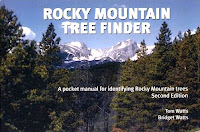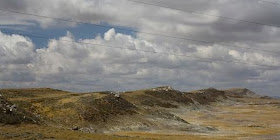 |
| Andy's Mystery Plant. |
Compounding the problem, characters for differentiating plant species tend to be small, or subtle to the human eye. While photos may seem the best means of identification, often it is difficult to capture key features and range of variation with photographs. There’s no getting around it -- plants can be tough to tell apart.
 |
| Los Osos Oaks on the Central Coast of California (Quercus agrifolia, the coast live oak). |
 Tree identification, on the other hand, usually is a realistic goal for the layperson, at least in North America (but see NOTE at end of post). There are far fewer species to consider, and many of the distinguishing features are easy to see. Field guides to trees use several approaches to identification. The Golden Field Guide Trees of North America (600 species) organizes trees by plant family, with illustrations and distinguishing features of each family provided at the beginning of the book. After choosing a family, one browses that section making choices based on brief descriptions of diagnostic features, distribution maps and illustrations. (Don't rule out this book based on lack of photos. Illustrations often are better at capturing diagnostic features of plants, counterintuitive though it may seem.)
Tree identification, on the other hand, usually is a realistic goal for the layperson, at least in North America (but see NOTE at end of post). There are far fewer species to consider, and many of the distinguishing features are easy to see. Field guides to trees use several approaches to identification. The Golden Field Guide Trees of North America (600 species) organizes trees by plant family, with illustrations and distinguishing features of each family provided at the beginning of the book. After choosing a family, one browses that section making choices based on brief descriptions of diagnostic features, distribution maps and illustrations. (Don't rule out this book based on lack of photos. Illustrations often are better at capturing diagnostic features of plants, counterintuitive though it may seem.)The Audubon Society’s Field Guide to North American Trees, Western Region (300 species, including common naturalized ones), takes an approach that is a bit more involved, but probably more successful in the end if one is willing to invest the effort (isn't that always the case though?). In the first part of the book, trees are grouped by leaf shape, or flower color, or fruit type. Photos are provided for each species to help with choice. One then looks up the chosen species in the second part of the book, where there are descriptions, line drawings and distribution maps. In the introductory section there are helpful drawings and definitions of important plant terms; becoming familier with these is a worthwhile time investment if one wants to get to know trees.
 |
| Indian Paintbrush, State Flower of Wyoming, is partially parasitic on other plants, including sagebrush. |
Then there are dichotomous keys. The name alone is off-putting, and these keys can be overwhelming to a novice or layperson due to the unfamiliar botanical terminology. Dichotomous keys are used extensively in professional manuals, though some online resources now offer more promising and intuitive approaches (see IdentifyLife for examples). A dichotomous key leads the user through a series of choices, each with two alternatives. Each step eliminates a group of plant species, finally arriving at the correct determination (usually).
 |
| Final steps in keying out the State Flower of Wyoming, the Indian Paintbrush. From Dorn 2001. |
But a dichotomous key can be a very useful tool, and does not have to be difficult. Identifying plants with dichotomous keys is much easier to understand if one actually does it ... so let’s have some fun and identify a tree!
 |
| Mystery Tree, Laramie, WY |
In North America, we're fortunate to have a relatively-simple tree flora (vs. the tropics ... oh my!) as well as a neat series of guides to tree identification -- the Tree Finders, for example the Rocky Mountain Tree Finder (RMTF). These little books are easy-to-use dichotomous keys. When I taught field botany at the University of Wyoming, the first day of class each summer included a field trip on campus identifying trees with our RMTFs. I’ve used Tree Finders with kids too young to read the choices themselves. They are a good introduction to dichotomous keys, they work well in many situations (but see NOTE at end of post) and they’re fun. As a demonstration, let's identify the tree on the right.
The RMTF’s dichotomous key starts on page 10, where we are asked if this tree has “needles or scale-like leaves” OR “ordinary leaves”:
Here we have to decide whether the needles are bundled OR single (needles are single, see close-up below).
And so we proceed through a series of decisions, always with two alternatives (page with choices shown below after photos):
if you can easily twirl a needle between thumb and finger;
OR if you can’t twirl it because it’s flattened
Answer: Ours are easy to twirl, I tried it.
needles are four-sided and leave little bumps on the twigs when they fall;
OR needles are round or oval in cross-section
Answer: Ours are the former, see bumps on twig below.
... it’s a SPRUCE! but what kind?
if the needles are tipped with hard, sharp points, making the branches painful to squeeze;
OR if you can squeeze a branch without saying “ouch”
Answer: These needles clearly are sharp-pointed!
... it’s a COLORADO BLUE SPRUCE (Picea pungens) and we’re done!
The final page for our tree has a drawing and map, which we use to confirm that our determination is correct -- yep, looks right and its range includes the mountains of southeast Wyoming. There also are life zones symbols -- the Colorado blue spruce grows in the montane and subalpine zones, as well as on the University of Wyoming campus.
 |
| Colorado blue spruce in front of Old Main, University of Wyoming, 2012. |
 |
| Old Main was the first building of the University; photo ca 1908. |
The Rocky Mountain Tree Finder is just one of a series of tree finders. The Pacific Coast Tree Finder was my introduction to dichotomous keys. I bought one several years before my first botany class, and was quite happy with it. There are many “finders” by the Nature Study Guild, including guides to winter trees, desert trees, birds, tracks, ferns, intertidal life, constellations and several for flowers of various regions. I’m skeptical about the last for reasons discussed in the beginning of the post, but I haven’t given them a try so can’t say for sure. There’s little financial risk in testing a Finder as they are cheap -- generally $4.95 each. To see the complete offering, visit Nature Study Guild Publishers.
The Pacific Coast Tree Finder, a real bargain at 75¢ (1973).
[NOTE: Some groups of trees are tough to identify to species, for example the willows. Others are problematic in particular regions -- e.g. some the maples of New England, or oaks in southern Arizona. In these cases you may still get close, down to a few species. Look at the distribution maps and life zone symbols for additional clues.]








































